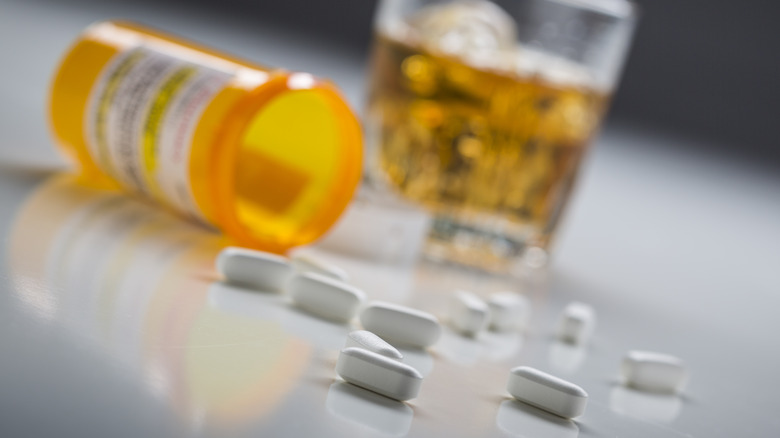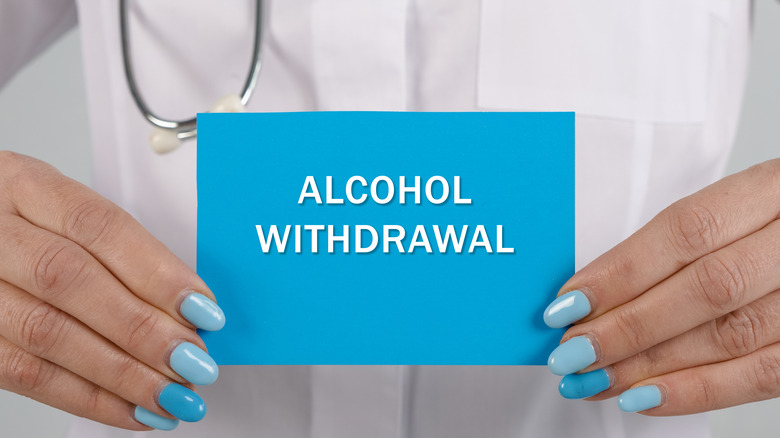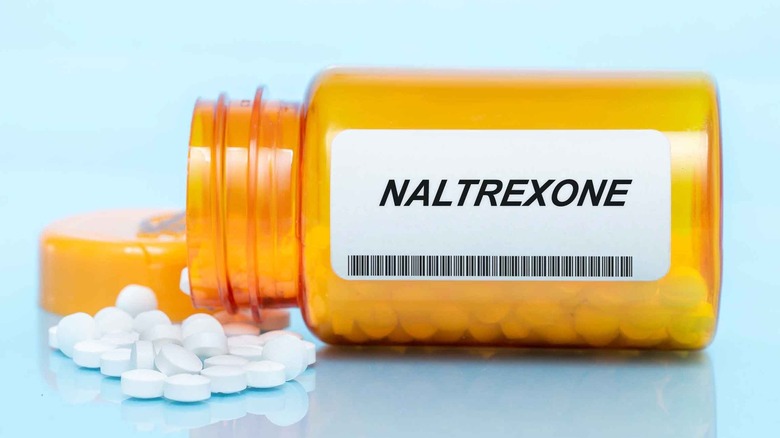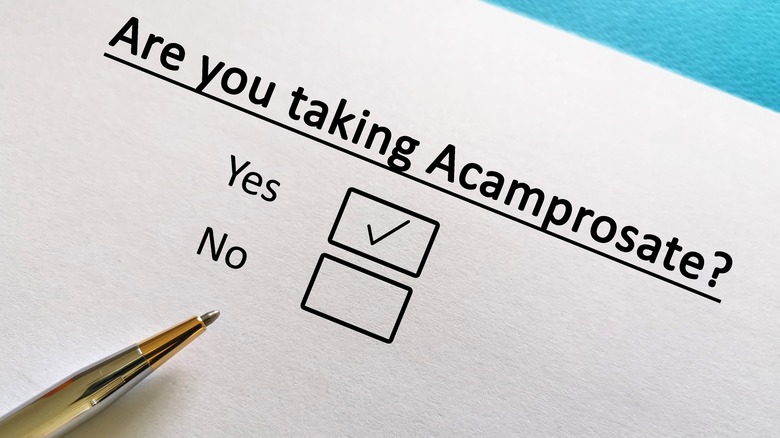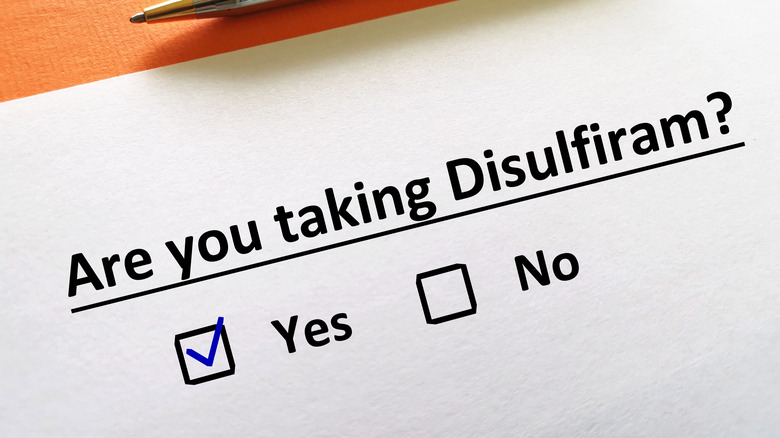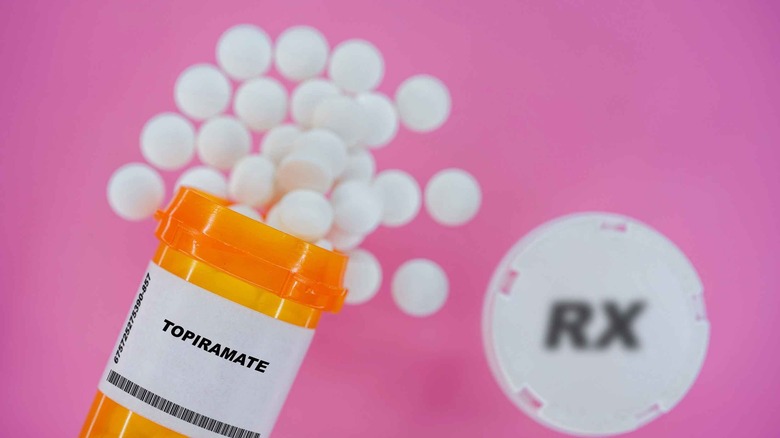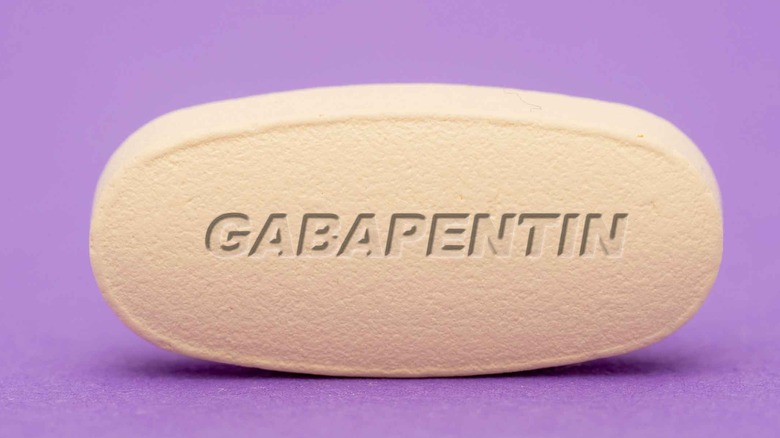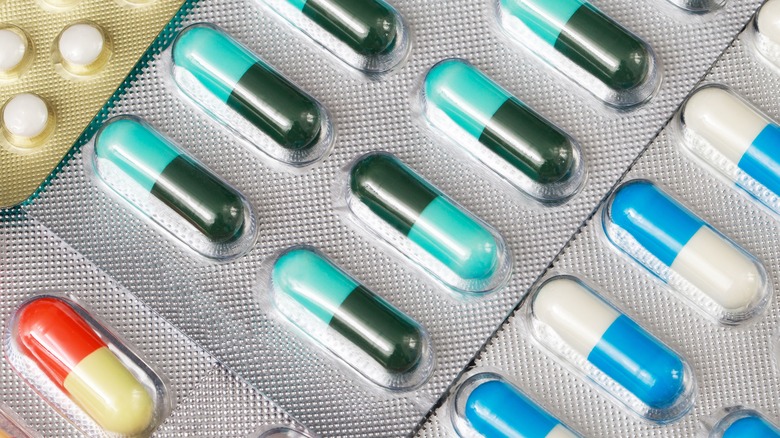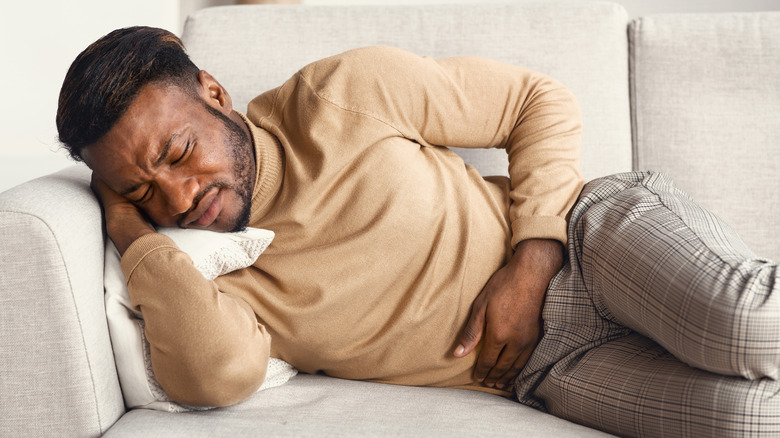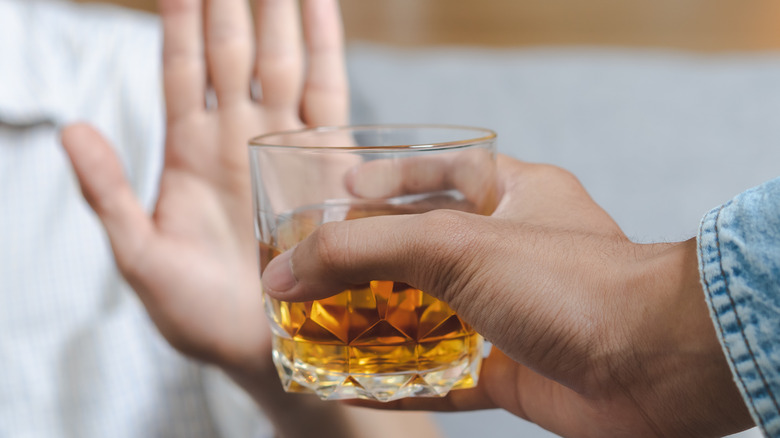The Most Effective Medications To Treat Alcoholism
As explained by the National Institute on Alcohol Abuse and Alcoholism (NIAAA), alcoholism (or alcohol use disorder) is a chronic or long-term condition characterized by a pattern of excessive drinking that affects your brain and its ability to control alcohol use. People with alcoholism have trouble stopping drinking alcohol despite its negative effects on overall health and social or work-related environments. It can result from a combination of genetic, environmental, and behavioral factors (e.g., a family history of alcoholism, depression, anxiety, or a emotional trauma), via Mayo Clinic.
Per the NIAAA, as of 2021, there were over 28 million cases of alcoholism in people over 18 years of age and over 800,000 cases in teens between 12 and 17 years old. Moreover, the Centers for Disease Control and Prevention states that alcoholism leads to over 140,000 deaths per year in the U.S., and is associated with huge economic costs that rounded $249 billion in 2010, making it a matter of public health concern. Unfortunately, quitting drinking alcohol may prove difficult due to the effects of alcohol withdrawal syndrome, a group of symptoms (like nausea, tremors, and sweating to hallucinations, seizures, or delirium tremens) which appear when someone with an alcohol addiction either abruptly stops drinking or significantly reduces their alcohol intake (via Healthline). Nevertheless, multiple medical interventions can help manage the symptoms of alcohol withdrawal syndrome and facilitate recovery, including various medications.
If you or anyone you know needs help with addiction issues, help is available. Visit the Substance Abuse and Mental Health Services Administration website or contact SAMHSA's National Helpline at 1-800-662-HELP (4357).
How do medications help treat alcoholism?
There are a number of medications that help treat alcoholism, and as the National Institute on Alcohol Abuse and Alcoholism explains, they help with the condition just as any other medication you'd take for the management of any chronic disorder like high blood pressure or asthma. While these medications have different mechanisms of action, their overall goal is to help people manage their alcohol withdrawal symptoms and maintain long-term sobriety. For instance, a 2019 study published in the journal Science Advances says that some drugs act by creating a negative association with alcohol intake, while others either reduce alcohol cravings, promote abstinence, or prevent relapses.
However, per the study, these medications don't work like magic. Instead, working with an interdisciplinary team of medical professionals that focuses on mental, emotional, social, and situational risk factors is critical for achieving better treatment outcomes. Similarly, factors such as a person's readiness or commitment towards modifying their drinking habits can highly influence the effectiveness and adherence to the treatment. In fact, the study explains that this is evidenced by the high placebo response rates seen in numerous clinical trials, in which the participants are already willing to change their drinking behaviors and show improvements when assigned to a placebo. Still, regardless of whether they provide actual or perceived effectiveness, keep in mind that, as with any other medication, these types of drugs should only be taken under the supervision of your healthcare provider.
Naltrexone
Among the prescription medications approved by the Food and Drug Administration (FDA) for the treatment of alcohol use disorder is naltrexone (Vivitrol), which, according to the Substance Abuse and Mental Health Services Administration (SAMHSA), belongs to a group of medications known as opioid antagonists. This class of drugs works by blocking opioid receptors in the brain. Yet, when it comes to alcohol use, naltrexone also binds to endorphin receptors, and thus, it blocks the rewarding feelings and effects of alcohol in the body. According to a meta-analysis published in the journal Addiction, it is believed that naltrexone then helps reduce alcohol cravings and, therefore, supports sobriety by preventing heavy drinking relapses.
Per Drugs.com, naltrexone is available as an extended-release injection or pill. The injection is given once a month into the buttock muscles, and it is recommended to alternate buttocks for each dose. The recommended dosage for injected naltrexone is 380 milligrams. In contrast, naltrexone tablets are taken daily at a dose of 50 milligrams. Nevertheless, SAMHSA notes that people should not take the drug while still being dependent on alcohol. Instead, they should wait until the alcohol detox period is over to start the treatment to avoid potential side effects. People with opioid dependence or those taking opioid-containing medicines for pain management should not take naltrexone because it will block its effects, which could lead to sudden opioid withdrawal symptoms and reduce the painkillers' effects, respectively.
Acamprosate
Per a 2023 article published in the International Journal of Environmental Research and Public Health, acamprosate (Campral) is a relatively safe prescription drug approved by the Food and Drug Administration that has been used to treat alcohol use disorders since 1989. It is believed to work by mimicking the effect of two neurotransmitters (a.k.a your brain's chemical messengers) that help calm or stabilize your brain's chemistry, which is disrupted by chronic alcohol consumption (via Drugs.com). Per the previously mentioned article, by balancing the neurotransmitters, the drug helps reduce alcohol cravings, as well as alcohol withdrawal symptoms. In fact, its primary use is to help achieve and sustain complete abstinence thanks to said effects, which is evidenced by the significantly higher treatment completion and success rates.
Acamprosate is taken orally at a dose of 666 milligrams 3 times a day, preferably with meals. However, its dosage may vary from one person to another, and a lower amount may also work for some people (per Drugs.com). Plus, it is typically started right after you've stopped drinking and withdrawal symptoms end. Yet, it should be continued in the case of a relapse. Lastly, it should be used together with a psychosocial intervention, behavioral therapies, or support groups for a better outcome, and always under the supervision of a healthcare professional.
Disulfiram
Disulfiram (Antabuse) is a medication used to treat alcoholism that works by creating unpleasant side effects when mixed with alcohol. According to a 2023 article published in the International Journal of Environmental Research and Public Health, it was the first drug approved by the Food and Drug Administration to be used for this purpose. Disulfiram's mechanism of action is the inhibition of the enzyme that metabolizes a toxic alcohol byproduct called acetaldehyde. This leads to its accumulation in the blood and results in unwanted side effects such as tachycardia or rapid heart rate, hyperventilation or shortness of breath, heat flashes, headache, nausea, vomiting, and anxiety or panic attacks.
Disulfiram is typically taken once a day, with or without food, and either in the morning or at bedtime, depending on whether or not it promotes a sedative effect. It comes in tablet form, and its initial dose (which is prescribed for up to two weeks) is 500 milligrams daily, which is also the maximum recommended dose. After the initial period, a maintenance dose is established at 250 milligrams once per day (via Drugs.com). While disulfiram is believed to be more effective than other drugs such as naltrexone or acamprosate due to the negative association with alcohol, its greater limitation is that, also due to these effects, patients often fail to take it, meaning that health professionals should constantly monitor its use. Note that disulfiram may also react to other alcohol-containing products such as mouthwash, cough medicine, cooking wine, or vinegar.
Topiramate
Topiramate (Eprontia, Topamax, Topiramate ER, Trokendi XR, or Topiragen) is an anticonvulsant medication (a drug that treats seizures) that hasn't yet been approved by the FDA as an official treatment for alcohol use disorder. However, both the U.S. Department of Veterans Affairs and the American Psychiatric Association recommend its use as an alternative alcoholism treatment, as stated in a 2022 review in the journal Drugs. While the exact mechanism of action of topiramate for alcohol use is not fully understood, it most likely affects specific chemical messengers or neurotransmitters in your brain, which reduces the activity of brain regions associated with drug cravings and addiction. This, in turn, translates to fewer alcohol cravings and alcohol withdrawal symptoms.
Topiramate comes in tablet and capsule form, and according to a 2016 study published in American Family Physician, it is usually started at a low dose of 25 milligrams, which can be gradually increased over time until reaching a maximum dose of 300 milligrams provided in two separate 150-milligram doses twice per day. Per Drugs.com, topiramate can be taken with or without food, and it should be swallowed whole without splitting or crushing it beforehand. According to the previously mentioned study, evidence suggests that aside from helping reduce drinking days, topiramate also seemed to decrease the likelihood of relapse. Since topiramate is originally prescribed as a seizure medication, it is crucial to follow the doctor's instructions carefully and promptly report any side effects or concerns.
Gabapentin
Per a 2022 review published in the journal Drugs, gabapentin (Gralise, Horizant, Neurontin, or Gabarone) is endorsed by the American Psychiatric Association (APA) as a treatment for alcohol use disorder, despite being an anti-seizure drug that's still not approved by the FDA to be used for that purpose. Like other anti-convulsants or anti-seizure medications, it mimics the activity of a brain neurotransmitter (or chemical messenger) called gamma-aminobutyric acid (GABA), which helps calm down your brain activity and leads to fewer alcohol withdrawal symptoms and cravings when trying to cut alcohol.
When prescribed as a medication for alcohol use, gabapentin's dosage seems to vary from 300 milligrams to 1,800 milligrams per day. According to a 2016 study in the journal American Academy of Family Physicians (AAFP), one potential drug schedule suggests starting with an initial dose of 300 milligrams on the first day and then continuing with 300-milligram increases each day until reaching a maximum dose of 1,800 milligrams per day. The study also presents evidence from clinical trials that suggest that Gabapentin may lead to more non-drinking days and reduced cravings when compared to a placebo.
Lastly, Drugs.com notes that while there are numerous brands of gabapentin, you shouldn't take them interchangeably if you can't find the one you're looking for, seeing that their dosage may be different. Thus, stick to the one prescribed by your healthcare provider, or talk to them about your available options.
Off-label medications
According to the Food and Drug Administration (FDA), the term "off-label" refers to the prescription of a medication for a purpose that is either not officially approved by the FDA or not stated in the product's labeling. In other words, it is the use of an approved drug for an unapproved purpose. When it comes to treating alcohol use disorder, there are quite a few off-label medications that are also prescribed as part of the treatment course that help get the desired effects via a different mechanism of action.
Per a 2019 study published in the journal Science Advances, aside from the two most common off-label drugs, the anti-seizures medications topiramate and gabapentin (which are not FDA-approved, but are supported by other American health officials), additional commonly prescribed off-label medicines for alcoholism treatment that have showed promising results in phase two or phase three medication trials include benzodiazepines (a class of anti-anxiety drugs, including lorazepam and diazepam), the anti-smoking medication varenicline, the antinausea drug ondansetron, the blood-pressure lowering drugs prazosin and doxazosin, the opioid receptor-blocking drug nalmefene (which has actually been approved in Europe since 2013 for the treatment of alcohol dependence and acts very similarly to the FDA-approved drug naltrexone), and the drug balcofen that is used to treat muscle spasms (which France approved in 2018 for alcohol use disorder, and has been long used in other European countries and Australia for the same purpose).
Side effects and interactions
Like all medications, those used for the treatment of alcohol use disorder have their share of potential side effects, which ultimately vary depending on the drug of choice. Common side effects among naltrexone, acamprosate, and disulfiram (the ones approved by the FDA) include headaches, nausea, dizziness, and weakness or fatigue, per the Agency for Healthcare Research and Quality (AHRQ). Nevertheless, they each have a long list of downsides of their own that you should consider in order to make an informed decision.
According to the AHRQ, naltrexone may also cause vomiting, anxiety, and drowsiness despite leading to trouble sleeping. In contrast, acamprosate may lead to diarrhea, reduced appetite, anxiety or depression, dry mouth, itching, sweating, numbness in the arms, hands, feet, or legs, and, again, trouble sleeping. Lastly, disulfiram has been associated with impotence (having trouble getting or keeping an erection), skin rashes or acne, and a peculiar metallic or garlic-like taste in the mouth. Plus, per Drugs.com, all three of these medications are classified as U.S. FDA pregnancy category C, meaning that animal studies show harmful effects on the baby, yet there are no available results from human studies. For the same reason, their use is not recommended while breastfeeding. Lastly, while there are no known drug interactions for acamprosate, naltrexone and disulfiram have a total of 321 and 184 drug interactions each, which may interfere with the treatment.
Alternative treatments
When it comes to choosing a treatment for alcoholism, there are various options to consider that don't rely on medications. According to the National Institute on Alcohol Abuse and Alcoholism, current available treatment options include behavioral treatments, which focus on counseling to help change your drinking behaviors, mutual-support groups such as Alcoholics Anonymous (A.A.) or other 12-step programs that focus on the support provided by people who either are or were in your shoes and, lastly, inpatient rehab centers, which are known for providing treatment while staying at a facility.
In addition, Alcoholism.org mentions other treatment options labeled as non-traditional yet potentially equally effective, such as yoga, acupuncture, meditation, light therapy, herbs, ashwagandha, kudzu extract, milk thistle, and nutritional counseling. Finally, the Agency for Healthcare Research and Quality suggests considering multiple factors when making a decision, such as your personal history of alcohol use, past attempts at quitting, the overall cost of treatment, whether sticking to your treatment plan might be something you can manage, your support system, and whether relying on medicines might be the best choice.
In the end, there isn't a universal solution that suits everyone, and what might be effective for one individual could be unsuitable for another, which is why a treatment plan that's tailored to your individual needs is key for success.
Tips for a successful recovery
When it comes to a successful recovery, HelpGuide.org recommends starting your journey toward sobriety with support from family and friends, counselors, or healthcare professionals, as building a support system can make your recovery easier. Joining support group meetings can also help you connect with others in recovery from whom you may learn valuable information. Afterwards, you can move on to setting achievable goals for your recovery journey, which should be clear, specific, and, most importantly, realistic. Writing them down or sharing them with your support system will help you get the accountability and help you may need from others. It will also make it easier to track your progress and celebrate every milestone (which helps reinforce your commitment to your recovery and motivate you to continue).
In addition, identify potential triggers (activities, places, situations, and even certain people) that may lead to drinking so you can avoid them. Also, look for healthy coping mechanisms or distractions to help you deal with cravings, such as exercise, meditation, listening to your favorite music, or running a quick errand. Lastly, remember that recovery is a journey that takes time and can often come with setbacks or slips.
To prevent relapses, American Addiction Centers recommends taking care of yourself physically, emotionally, and mentally, which can include getting enough sleep, eating a healthy diet, and engaging in self-care activities like practicing positive self-talk. In any case, be patient with yourself and celebrate small victories along the way.
